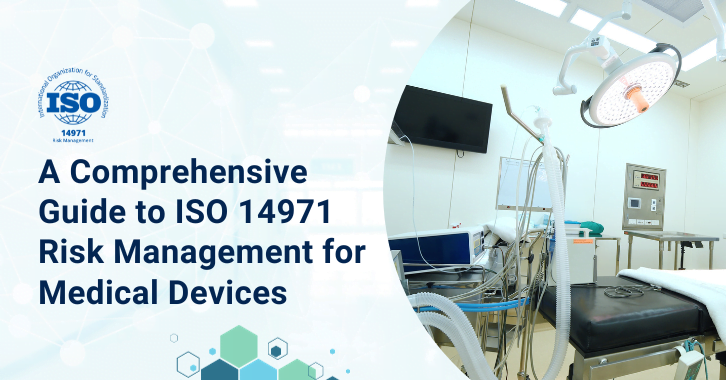
Safety is of paramount importance when it comes to medical devices. These devices are designed to save lives, improve health, and aid in diagnostics; hence, they must adhere to the highest standards. ISO 14971 risk management for medical devices serves as an internationally recognized standard for risk management pertaining to medical devices. This standard outlines the best practices for identifying, evaluating, and controlling risks throughout the lifecycle of a medical device. The aim is not just to make the device safe but also to ensure that the benefits far outweigh the risks.
Understanding ISO 14971

ISO 14971, updated most recently in 2019, is an ISO (International Organization for Standardization) standard that provides a comprehensive framework for risk management for medical devices. Its scope is broad, covering all stages of the medical device lifecycle from design and development to production and post-production. Manufacturers and stakeholders use this standard as a guideline to systematically manage risks and thereby ensure that medical devices are as safe as possible.
Key Principles
 Navigating the complex landscape of medical device manufacturing requires stringent risk management to ensure patient safety and compliance with regulatory standards. This is where the Essential ISO 14971 Principles come into play, serving as the backbone of effective risk management strategies. From initial Risk Assessment to ongoing Risk Review, these principles guide manufacturers through a systematic approach that includes identifying, controlling, evaluating, and documenting potential risks. Each principle focuses on a crucial aspect of risk management, ensuring that both the medical devices and the patients using them are as safe as possible.
Navigating the complex landscape of medical device manufacturing requires stringent risk management to ensure patient safety and compliance with regulatory standards. This is where the Essential ISO 14971 Principles come into play, serving as the backbone of effective risk management strategies. From initial Risk Assessment to ongoing Risk Review, these principles guide manufacturers through a systematic approach that includes identifying, controlling, evaluating, and documenting potential risks. Each principle focuses on a crucial aspect of risk management, ensuring that both the medical devices and the patients using them are as safe as possible.
Essential ISO 14971 Principles:

– Risk Assessment: The first step is to comprehensively assess potential risks associated with the medical device. This includes understanding the scope of hazards, potential harm, and the likelihood of occurrence.
– Risk Control: After identifying the risks, the next step is to control these risks. This could be through design alterations, protective measures, or warning labels.
– Risk Evaluation: Each identified risk is evaluated to determine its significance. The process involves comparing the estimated risk against predetermined criteria.
– Risk Review: Constant reviews are conducted to assess the effectiveness of the risk control measures implemented.
– Documentation: Proper documentation of all iso 14971 risk management activities is essential for verification, validation, and quality audits.
Implementation and Benefits

The journey from understanding ISO 14971 principles to reaping their full benefits begins with strategic implementation. This involves a multi-faceted approach, starting with meticulous planning and culminating in rigorous verification and validation processes. By laying out a comprehensive risk management plan, assembling a multidisciplinary team, and undertaking thorough risk analyses, manufacturers set the stage for robust risk evaluation and control measures. Beyond enhancing device safety, a well-executed implementation process provides invaluable insights and creates a strong foundation for regulatory compliance. It’s a roadmap not just for creating a safer product but also for instilling confidence among stakeholders, from regulatory bodies to end-users.
Implementing ISO 14971:

– Planning: Create a risk management plan outlining the approach, roles, responsibilities, and activities.
– Team Formation: Assemble a risk management team comprising experts in medical devices, healthcare, engineering, and quality assurance.
– Risk Analysis: Conduct a thorough risk analysis, including failure modes and effects analysis (FMEA).
– Risk Evaluation and Control: Identify suitable measures to control or eliminate risks and put them into practice.
– Verification and Validation: Ensure that the risk control measures are effective through rigorous testing.
– Documentation and Records: Keep records of all activities, evaluations, and results for future references and audits.
Benefits of Compliance

In the complex landscape of medical device manufacturing, compliance with ISO 14971 serves as a beacon that illuminates multiple avenues of benefits. At the heart of these is the assurance of patient safety, a non-negotiable priority in healthcare. Beyond this noble goal, adherence to this standard paves the way for smoother regulatory approvals, making it a global passport of sorts in the medical device market. It also serves as a proactive strategy for reducing legal liabilities, enhancing overall product quality, and fortifying consumer trust. While there might be an initial investment in implementing these guidelines, the long-term financial gains manifested through reduced recalls and elevated brand reputation make it a cost-effective decision. In sum, compliance with ISO 14971 is not just a regulatory requirement but a multi-faceted advantage for manufacturers in this industry.
– Patient Safety: The most critical benefit is improved patient safety. Medical devices that comply with ISO 14971 are subjected to rigorous testing and assessment, ensuring that they meet the highest safety standards.
– Regulatory Approval: Regulatory bodies worldwide recognize ISO 14971. Complying with this standard can smooth the way for approvals and certifications.
– Reduced Liability: Comprehensive risk management minimizes the chances of device failure, thereby reducing legal liabilities.
– Quality Improvement: Following ISO 14971 guidelines ensures a quality-centric approach to device manufacturing, which in turn boosts market reputation and customer trust.
– Cost-Effectiveness: Although implementation may seem costly initially, the long-term benefits include reduced recalls and increased brand reputation, which are financially advantageous.
Conclusion
Understanding and implementing ISO 14971 for medical device risk management is not merely a regulatory requirement but a moral obligation for manufacturers. Ensuring patient safety while enhancing the efficiency and effectiveness of medical devices is the call of the hour. If you’re in the business of developing or manufacturing medical devices, adopting ISO 14971 risk management standards will undoubtedly elevate your brand to global recognition for quality and safety. Take action now; it’s never too late to implement best practices for the welfare of humanity.
By adhering to the principles and guidelines outlined by ISO 14971, you’re not just complying with a standard; you’re committing to the well-being of patients worldwide. So take the steps needed to make your medical devices as safe as they can possibly be. Your brand, your industry, and most importantly, your patients, will thank you for it.
Total Lean Management (TLM)
Total Lean Management (TLM) offers a comprehensive Quality Management System (QMS) software designed specifically for medical device companies. The software provides easy compliance with various industry standards such as ISO 13485, ISO 14971, MDSAP, and FDA 21 CFR Part 11/820, among others. TLM’s unique Upstream/Downstream dual technology user environment allows quality professionals and other users to access the features they need without being overwhelmed by the system. The software is especially beneficial for startups, as it allows for electronic compliance and risk management from the prototype stage through production, without diverting resources from R&D efforts. Its features include linking capabilities between ISO and FDA requirements, engineering change management, and purchase orders linked to approved suppliers. TLM’s platform also boasts a long track record of FDA audits, giving users confidence in its robust compliance capabilities. Contact us today to learn more.





 Demos
Demos